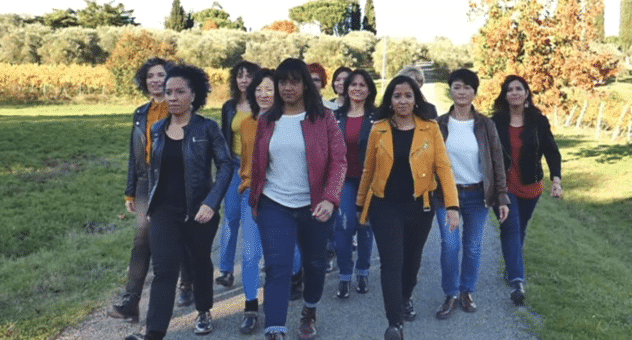
Dec 11, 2020 | Non categorizzato
The new Gen Verde single to support concrete and collective projects to protect Creation Turn Around, Gen Verde’s new single, grew out of a desire to reflect and stimulate concrete action to safeguard the earth, being inspired by contemplating the earth’s beauty.  It is a song that is both a prayer and a cry in chorus, a reflection and action, one that instills hope and the desire for change. From young Greta Thunberg’s speech at the UN to Pope Francis’ words in “Laudato Si'”, from the astronaut James Buchli to Chiara Lubich… these were the main inspirations for the new song written by Nancy Uelmen which speaks openly about climate problems and calls for a change of direction giving a voice to what young people are demanding: “It really impresses me to see these young people trying to do something because their future is at risk. As Gen Verde we wondered what we could do and, since we love expressing ourselves through music, we had the idea of writing a song to show the earth’s beauty and put at the centre of our attention Creation as a gift we have received to be protected and taken care of.” . The words are even more powerful when sung by young people from different parts of the world as a choir: from the United States of America to India, from Ireland to Nigeria, New Caledonia and many other countries. “It was a really strong experience,” says Colomba, “when, in spite of the pandemic and not being able to meet physically in a recording studio, we asked lots of young people to give us a hand by recording their contribution to this song. When we put the different voices together we were deeply moved because this song is already carrying the regenerative strength of a group that really wants to reverse this negative trend and who have experienced this, even if at a distance”. And while keeping a compelling style of music for a young audience, this song has also a genuine prayer: “We turn to the “Creator Spirit” (which reminds us a bit of the Schola Gregoriana’s “Veni Creator Spiritus”)” – continues Nancy – “because we feel we need God’s help to have the light to understand how to heal our common home and, more importantly, to change our hearts… not just my heart or someone else’s but the hearts of the whole community”. And of course the lyrics are infused with a hope that is typical of Gen Verde’s songs and a firm belief in the strength of commitment of many to the common good. The song is written in a mainly electronic pop style. It maintains elements of continuity with Gen Verde’s latest albums but at certain points, the music style deviates slightly to encourage personal and collective reflection, inviting people to make a commitment to save the earth. It is a strong commitment which is why the new Turn Around video clip was performed live for the first time at the international meeting entitled The Economy of Francesco. Link YouTube Turn Around.
It is a song that is both a prayer and a cry in chorus, a reflection and action, one that instills hope and the desire for change. From young Greta Thunberg’s speech at the UN to Pope Francis’ words in “Laudato Si'”, from the astronaut James Buchli to Chiara Lubich… these were the main inspirations for the new song written by Nancy Uelmen which speaks openly about climate problems and calls for a change of direction giving a voice to what young people are demanding: “It really impresses me to see these young people trying to do something because their future is at risk. As Gen Verde we wondered what we could do and, since we love expressing ourselves through music, we had the idea of writing a song to show the earth’s beauty and put at the centre of our attention Creation as a gift we have received to be protected and taken care of.” . The words are even more powerful when sung by young people from different parts of the world as a choir: from the United States of America to India, from Ireland to Nigeria, New Caledonia and many other countries. “It was a really strong experience,” says Colomba, “when, in spite of the pandemic and not being able to meet physically in a recording studio, we asked lots of young people to give us a hand by recording their contribution to this song. When we put the different voices together we were deeply moved because this song is already carrying the regenerative strength of a group that really wants to reverse this negative trend and who have experienced this, even if at a distance”. And while keeping a compelling style of music for a young audience, this song has also a genuine prayer: “We turn to the “Creator Spirit” (which reminds us a bit of the Schola Gregoriana’s “Veni Creator Spiritus”)” – continues Nancy – “because we feel we need God’s help to have the light to understand how to heal our common home and, more importantly, to change our hearts… not just my heart or someone else’s but the hearts of the whole community”. And of course the lyrics are infused with a hope that is typical of Gen Verde’s songs and a firm belief in the strength of commitment of many to the common good. The song is written in a mainly electronic pop style. It maintains elements of continuity with Gen Verde’s latest albums but at certain points, the music style deviates slightly to encourage personal and collective reflection, inviting people to make a commitment to save the earth. It is a strong commitment which is why the new Turn Around video clip was performed live for the first time at the international meeting entitled The Economy of Francesco. Link YouTube Turn Around.
Tiziana Nicastro
Dec 10, 2020 | Non categorizzato
Three exemplary figures, witnesses that dialogue among religions is possible, all died on 1 December. Men for fraternity. Passionate about the adventure of dialogue among believers of different religions. United by a desire to live in unity, whilst mindful of faith, culture and sensitivity. Imam Nedal Abu Tabaq, muftī of the Muslim League in Poland, the Theravada Buddhist monk Phra Ajahn Eiam, and Henri Teissier, Catholic bishop of Oran, in the north of Algeria, and archbishop of Algiers all died on the same day – December 1st. For their friends on the road of inter-religious dialogue, there remains the the task of taking up their inheritance and renewing their commitment to universal fraternity. Roberto Catalano who is co-responsible for inter-religious dialogue for the Focolare Movement recalls that the Mufti Nedal Abu Tabaq encouraged the start of a path of dialogue among Muslims, Christians and Jews in Poland. Working with believers of the three religions, he promoted numerous events including concerts, symposia and gatherings on the occasion of religious festivals. The latter were always opportunities to share beliefs, values and traditions and a time to create mutual understanding. He worked with the local authorities in the production of a “Calendar of the Three Religions: Judaism, Christianity, Islam”. In 2013 he established the “Day of Christianity among Muslims in Poland” on 29th May and the following year the “Day of Judaism among Muslims in Poland” on the 16th of the month. In 2014 the Mufti participated in an Interreligious Conference dedicated to Chiara Lubich, on the fifth anniversary of her death. He died a victim of the coronavirus pandemic. Phra Ajahn Eiam, a Thai Theravada Buddhist monk, is remembered for his encouraging smile, which always lit up his discreet, silent, meditative presence. He was committed to Buddhist-Christian dialogue. Suffering from a tumour, his condition deteriorated with the onset of Covid-19 infection. Bishop Henri Teissier, was born in Lyon and ordained a priest in Algiers in 1955. He was archbishop of the Algerian capital for twenty years. He was a man of dialogue, committed to understanding, respect and esteem among believers in Islam and Christianity. “A lover of Algeria, its people, its language and its culture,” the press agency of the Italian Episcopal Conference reminds us. “He led the Church in Algeria during the tumult of the 1990s, when nineteen nuns and priests and Bishop Pierre Claverie were all assassinated between 1994 and 1996.” Even during the difficult years of the civil war Archbishop Teissier “served the Church and fostered its very vocation of friendship and fraternity with the Algerian people.”. Following his retirement, he devoted his time to writing and participated in conferences all over the world. He died after suffering a stroke. Three exemplary figures, witnesses that dialogue is possible.
Claudia Di Lorenzi
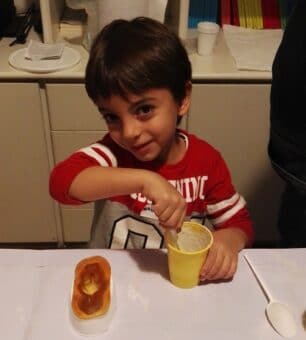
Dec 9, 2020 | Non categorizzato
As in previous years the Gen4, children in the Focolare Movement, are once again getting involved in this project to remind everyone of the true meaning of Christmas. 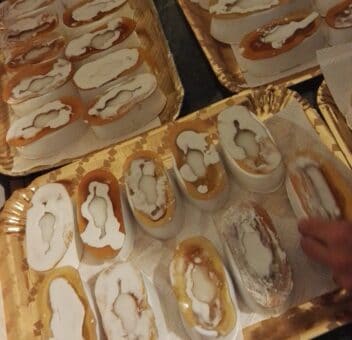 With the pandemic currently forcing us to avoid personal contact, the Gen4 – boys and girls aged 4-8 in the Focolare Movement – were really wondering how they could prepare for Christmas. “How are we going to do the “they have evicted Jesus” project this year? Will we be able to get together to make the plaster figures of Baby Jesus? Will we be able to go out into the streets to give Jesus to people?” Founded in 1997 this gen4 project goes far beyond the literal meaning of the words: it is about not allowing ourselves to be conditioned by consumerism, but putting real values at the heart of Christmas. The idea came from a reflection by Chiara Lubich who was in Switzerland in the period before Christmas. Walking through the illuminated streets of a big city, Chiara was struck by the lights, the graceful decorations, by so much wealth but above all by the absence of any reference to the meaning of the first Christmas. She wrote: “this rich world has “taken” Christmas and all its trappings but has evicted Jesus! (…) The world focuses on Christmas for the best earnings of the year but it does not think about Jesus”. Since 1997 thousands of Gen4 all over the world have responded to Chiara’s invitation to put Jesus back at the centre of Christmas.
With the pandemic currently forcing us to avoid personal contact, the Gen4 – boys and girls aged 4-8 in the Focolare Movement – were really wondering how they could prepare for Christmas. “How are we going to do the “they have evicted Jesus” project this year? Will we be able to get together to make the plaster figures of Baby Jesus? Will we be able to go out into the streets to give Jesus to people?” Founded in 1997 this gen4 project goes far beyond the literal meaning of the words: it is about not allowing ourselves to be conditioned by consumerism, but putting real values at the heart of Christmas. The idea came from a reflection by Chiara Lubich who was in Switzerland in the period before Christmas. Walking through the illuminated streets of a big city, Chiara was struck by the lights, the graceful decorations, by so much wealth but above all by the absence of any reference to the meaning of the first Christmas. She wrote: “this rich world has “taken” Christmas and all its trappings but has evicted Jesus! (…) The world focuses on Christmas for the best earnings of the year but it does not think about Jesus”. Since 1997 thousands of Gen4 all over the world have responded to Chiara’s invitation to put Jesus back at the centre of Christmas.  In previous years, before we had Covid, the Gen4 offered plaster figures of Baby Jesus or all kinds of nativity scenes they had made themselves in the streets and squares, in the markets, at local institutions and in schools together with a copy of Chiara Lubich’s writing entitled “they have evicted Jesus”. Inherent in this project is the dimension of “gift”, of being aware of others: every year the gen4 think of initiatives to support children their own age in other parts of the world who, like Baby Jesus, lack basic necessities. The people who receive the “Little Baby” often make a spontaneous donation to the particular cause. Last Christmas using the money raised Gen4 centres around the world were able to help the “Centro Social Unidad” (Unity Social Centre) in Bogotá, Colombia, a centre which welcomes children who have emigrated from Venezuela and the Institut de Réducation Audio Phonétique (IRAP) which is the Institute for Deaf Children in the Lebanon. This year everything will be a bit different because the pandemic has taken away some of our freedom. Nevertheless, ideas and creativity for putting Jesus back at the heart of Christmas have not been lacking. How did they manage to make and offer the little plaster figures? In the family, in small groups, in their neighbourhoods and in parishes whilst still respecting all the restrictions and rules in places for this pandemic. This year they also decided to help the “Collegio Fiore” (Flower College) in Guatemala. The project’s financial situation has got worse because of the pandemic which has meant having to temporarily suspend all school activities. They really need the support of the “Jesus is missing” activity so that children can return to school as soon as possible under improved conditions. For more information visit the sito dei e delle Gen4.
In previous years, before we had Covid, the Gen4 offered plaster figures of Baby Jesus or all kinds of nativity scenes they had made themselves in the streets and squares, in the markets, at local institutions and in schools together with a copy of Chiara Lubich’s writing entitled “they have evicted Jesus”. Inherent in this project is the dimension of “gift”, of being aware of others: every year the gen4 think of initiatives to support children their own age in other parts of the world who, like Baby Jesus, lack basic necessities. The people who receive the “Little Baby” often make a spontaneous donation to the particular cause. Last Christmas using the money raised Gen4 centres around the world were able to help the “Centro Social Unidad” (Unity Social Centre) in Bogotá, Colombia, a centre which welcomes children who have emigrated from Venezuela and the Institut de Réducation Audio Phonétique (IRAP) which is the Institute for Deaf Children in the Lebanon. This year everything will be a bit different because the pandemic has taken away some of our freedom. Nevertheless, ideas and creativity for putting Jesus back at the heart of Christmas have not been lacking. How did they manage to make and offer the little plaster figures? In the family, in small groups, in their neighbourhoods and in parishes whilst still respecting all the restrictions and rules in places for this pandemic. This year they also decided to help the “Collegio Fiore” (Flower College) in Guatemala. The project’s financial situation has got worse because of the pandemic which has meant having to temporarily suspend all school activities. They really need the support of the “Jesus is missing” activity so that children can return to school as soon as possible under improved conditions. For more information visit the sito dei e delle Gen4.
Lorenzo Russo

Dec 8, 2020 | Non categorizzato
God does not let himself be outdone in generosity and He surprises us with His providence. This is confirmed by the experience of Urs, from Switzerland: a gesture made out of love can have many positive effects. I was invited to celebrate Christmas Eve with my two brothers and their wives. I wanted to give each of them a present, but there was no money. So, I placed my wish into God’s hands.  A few days ago, our friend Peter, a pastor in the Reformed Church, invited us to his parish community to make candles out of beeswax. It is a tradition in many places here, but I had never been involved. I went with the others to make my candle and, to my surprise, I saw that it was beautiful. I remembered that my younger brother’s wife is a candle enthusiast. The first gift was ready!
A few days ago, our friend Peter, a pastor in the Reformed Church, invited us to his parish community to make candles out of beeswax. It is a tradition in many places here, but I had never been involved. I went with the others to make my candle and, to my surprise, I saw that it was beautiful. I remembered that my younger brother’s wife is a candle enthusiast. The first gift was ready!  Every now and then I go and help out in a small company run by my friends, especially when they have to prepare a shipment and are under pressure. The last time I helped, a couple of weeks ago, during a break, I looked in the warehouse among the items they sell and I found a nice box full of notebooks: one a phone book, another a diary, etc … They were very beautiful. I asked the price, but it was beyond what I could afford. So, I continued preparing the shipment. It was an intense day of work. In the end I was tired, but happy to have lent a hand. When I was leaving, the person in charge gave me a bag thanking me for the help I had given during the year. I opened the bag and I was almost in tears: it was the box with those notepads. The gift for my older brother was ready!
Every now and then I go and help out in a small company run by my friends, especially when they have to prepare a shipment and are under pressure. The last time I helped, a couple of weeks ago, during a break, I looked in the warehouse among the items they sell and I found a nice box full of notebooks: one a phone book, another a diary, etc … They were very beautiful. I asked the price, but it was beyond what I could afford. So, I continued preparing the shipment. It was an intense day of work. In the end I was tired, but happy to have lent a hand. When I was leaving, the person in charge gave me a bag thanking me for the help I had given during the year. I opened the bag and I was almost in tears: it was the box with those notepads. The gift for my older brother was ready!  A few days ago, a friend gave me an envelope with money: He said: “It’s for you – for your personal needs”. Since it was the day of the Christmas market in our village, I went to have a look, but the prices seemed exaggerated. Before I left, I discovered the stand of a farmer who produced organic vinegar enriched with ginger, just what my older brother’s wife likes. It was packaged in a nice little bottle and the money I received was just enough to buy it. Another little gift was ready! When I got home, a friend tells me that he has received a leather briefcase, which he doesn’t need because he already has one and asks me if I could use it. So, I thought about my younger brother, it could be useful as he deals in consultations and estimates. Then I heard from him that, a few days before, his own had broken, so mine arrived just at the right moment! In the end the presents were ready. A personal note was added to the gift, thanking each person for what they meant to me. It was nice, they were very happy! I thought I would go to the Christmas party empty-handed, but Someone thought to find me a gift for each one.
A few days ago, a friend gave me an envelope with money: He said: “It’s for you – for your personal needs”. Since it was the day of the Christmas market in our village, I went to have a look, but the prices seemed exaggerated. Before I left, I discovered the stand of a farmer who produced organic vinegar enriched with ginger, just what my older brother’s wife likes. It was packaged in a nice little bottle and the money I received was just enough to buy it. Another little gift was ready! When I got home, a friend tells me that he has received a leather briefcase, which he doesn’t need because he already has one and asks me if I could use it. So, I thought about my younger brother, it could be useful as he deals in consultations and estimates. Then I heard from him that, a few days before, his own had broken, so mine arrived just at the right moment! In the end the presents were ready. A personal note was added to the gift, thanking each person for what they meant to me. It was nice, they were very happy! I thought I would go to the Christmas party empty-handed, but Someone thought to find me a gift for each one.
collected by Gustavo E. Clariá
Dec 7, 2020 | Non categorizzato
Chiara Lubich’s consecration to God on December 7, 1943, when she was 23 years old, laid the foundations of the Focolare Movement. Sixty years later she recalled that moment in a telephone linkup, inviting all members of the Movement to give their lives to God once more. … Looking back today, we can understand what the 7th of December 1943, the year of the Movement’s birth decades ago, can tell us. It tells us that a charism of the Holy Spirit, a new light came down on earth during those days, a light that, in the mind of God, was destined to quench the burning thirst of this world with the water of Wisdom, to warm it with divine love and thus give life to a new people nourished by the Gospel. And God decided to call me, a girl like many others, and hence my consecration to him, my “yes” to God, soon followed by the “yes” said by many other young women and men. That day speaks of light, then, and of people giving their lives to God as instruments in his hands for the achievement of his goals. Light and giving our lives to God: two realities that were extremely useful at that time when there was general confusion, mutual hatred and war. It was a time of darkness, when God’s love, his peace, joy and guidance seemed to be absent from the world, and it seemed that no one was interested in him. Light and giving our lives to God, two words which heaven wants to repeat to us again today, when many wars continue to be waged on our planet and terrorism has appeared as something even more frightening. Light means the Word, the Gospel, which is still too little known and, above all, not lived enough. Giving our lives to God is more necessary and right than ever today, considering that men and women who join causes the pursued by terrorism are ready to give their lives. What then should we Christians do, as followers of a God who was crucified and forsaken in order to bring about a new world, for our salvation and for that Life which will never end? … We should go out again into the world as living Gospels, so as to immerse it in its Light. We can do this by continuing to live God’s will in the present moment … without forgetting the Word of Life, which is taken from Scripture and offered to us month by month. … And, almost as if we were reborn, let’s give ourselves completely to God once more, in the path he has chosen for each one of us. In this way, the present and future that God gives us will also be pleasing to him.
Chiara Lubich
(From a telephone conference call, Rocca di Papa, 25th April 1991)
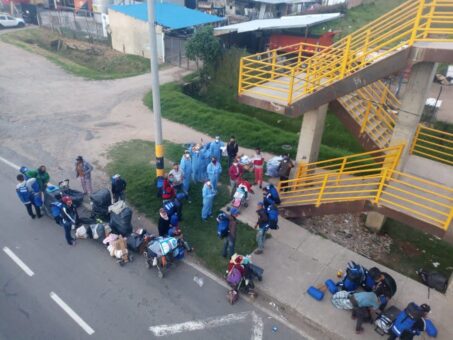
Dec 5, 2020 | Non categorizzato
The help of the Focolare communities in Latin American countries: actual gestures to be “all brothers (and sisters)”, as Pope Francis invoked in his last encyclical. 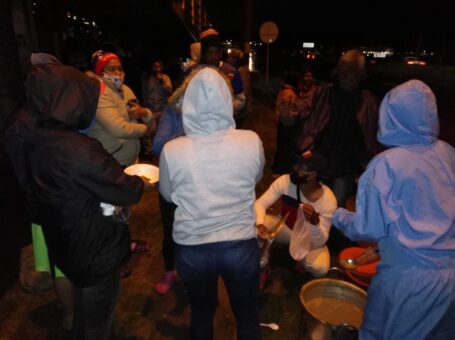 In Peru and in the other Latin American countries we see the continuous arrival of migrants, especially from Venezuela, but also Cuba, Central America, Haiti, and Arab countries. The Focolare communities are committed every day to helping these people. Silvano Roggero, a focolarino in Peru tells us: “Our adventure in Peru begins a few days before Christmas 2017. We invited some Venezuelans we met for lunch at home. At first there were five of them, later on we moved to the “Juan Carlos Duque” Centre because more than 120 people came! I remember Geno’s meeting with Karlin and her three young children. Crouching on the pavement, she was selling sweets. Geno heard a loud voice inside: “It’s Jesus!”. Going back he buys some sweets and invites her to lunch. That Sunday she came with the 3 children and also brought her sister with her two children!” In Colombia near Bogotá, Alba, who arrived as a migrant from Venezuela in 2014, has become a point of reference for the “Caminantes” (migrants) who pass by daily at the local Centre. One day, she hadn’t had lunch yet when a pregnant woman with her partner visited the centre needing medical attention. At the local dispensary there was a very attentive and kind nurse who could help them. Despite the cold, the hunger, the worry of leaving her volunteer colleagues alone at the Centre and also her children at home without lunch, Alba accompanied them to the dispensary and waited with them. At the end of the visit she accompanied the two young parents back to the Centre, and guess what happened? The Caminantes, knowing what Alba had done for the couple, put together some money to buy two cartons of eggs for her, her children and colleagues! Truly a hundredfold! From whom? From those who need it most!
In Peru and in the other Latin American countries we see the continuous arrival of migrants, especially from Venezuela, but also Cuba, Central America, Haiti, and Arab countries. The Focolare communities are committed every day to helping these people. Silvano Roggero, a focolarino in Peru tells us: “Our adventure in Peru begins a few days before Christmas 2017. We invited some Venezuelans we met for lunch at home. At first there were five of them, later on we moved to the “Juan Carlos Duque” Centre because more than 120 people came! I remember Geno’s meeting with Karlin and her three young children. Crouching on the pavement, she was selling sweets. Geno heard a loud voice inside: “It’s Jesus!”. Going back he buys some sweets and invites her to lunch. That Sunday she came with the 3 children and also brought her sister with her two children!” In Colombia near Bogotá, Alba, who arrived as a migrant from Venezuela in 2014, has become a point of reference for the “Caminantes” (migrants) who pass by daily at the local Centre. One day, she hadn’t had lunch yet when a pregnant woman with her partner visited the centre needing medical attention. At the local dispensary there was a very attentive and kind nurse who could help them. Despite the cold, the hunger, the worry of leaving her volunteer colleagues alone at the Centre and also her children at home without lunch, Alba accompanied them to the dispensary and waited with them. At the end of the visit she accompanied the two young parents back to the Centre, and guess what happened? The Caminantes, knowing what Alba had done for the couple, put together some money to buy two cartons of eggs for her, her children and colleagues! Truly a hundredfold! From whom? From those who need it most!  At the end of 2018, the Focolare community in Mexico City joined in the “humanitarian reception” of groups of migrants. A civil association inspired by the charism of the Focolare Movement gave its technical contribution and coordination to the authorities. A location was established to facilitate the collection and distribution of food, clothes, personal hygiene products and dozens of blankets. You can imagine the gratitude of the migrants. Brazil has also welcomed many migrants. The local community reports: “The multiplication of donations surprises us. We make a request for a heater, suddenly we get much more. Someone asks us for a sink and the next day a person we don’t know offers to help and donates five. One day a friend goes to buy something to give us. He explains to the shopkeeper the reasons for the purchase and is surprised by the discount and the free delivery offered . On another occasion a person we don’t know tells us: “I will organise an event and with the proceeds I will order some food for you to send to those who need it”.
At the end of 2018, the Focolare community in Mexico City joined in the “humanitarian reception” of groups of migrants. A civil association inspired by the charism of the Focolare Movement gave its technical contribution and coordination to the authorities. A location was established to facilitate the collection and distribution of food, clothes, personal hygiene products and dozens of blankets. You can imagine the gratitude of the migrants. Brazil has also welcomed many migrants. The local community reports: “The multiplication of donations surprises us. We make a request for a heater, suddenly we get much more. Someone asks us for a sink and the next day a person we don’t know offers to help and donates five. One day a friend goes to buy something to give us. He explains to the shopkeeper the reasons for the purchase and is surprised by the discount and the free delivery offered . On another occasion a person we don’t know tells us: “I will organise an event and with the proceeds I will order some food for you to send to those who need it”.
Lorenzo Russo

 It is a song that is both a prayer and a cry in chorus, a reflection and action, one that instills hope and the desire for change. From young Greta Thunberg’s speech at the UN to Pope Francis’ words in “Laudato Si'”, from the astronaut James Buchli to Chiara Lubich… these were the main inspirations for the new song written by Nancy Uelmen which speaks openly about climate problems and calls for a change of direction giving a voice to what young people are demanding: “It really impresses me to see these young people trying to do something because their future is at risk. As Gen Verde we wondered what we could do and, since we love expressing ourselves through music, we had the idea of writing a song to show the earth’s beauty and put at the centre of our attention Creation as a gift we have received to be protected and taken care of.” . The words are even more powerful when sung by young people from different parts of the world as a choir: from the United States of America to India, from Ireland to Nigeria, New Caledonia and many other countries. “It was a really strong experience,” says Colomba, “when, in spite of the pandemic and not being able to meet physically in a recording studio, we asked lots of young people to give us a hand by recording their contribution to this song. When we put the different voices together we were deeply moved because this song is already carrying the regenerative strength of a group that really wants to reverse this negative trend and who have experienced this, even if at a distance”. And while keeping a compelling style of music for a young audience, this song has also a genuine prayer: “We turn to the “Creator Spirit” (which reminds us a bit of the Schola Gregoriana’s “Veni Creator Spiritus”)” – continues Nancy – “because we feel we need God’s help to have the light to understand how to heal our common home and, more importantly, to change our hearts… not just my heart or someone else’s but the hearts of the whole community”. And of course the lyrics are infused with a hope that is typical of Gen Verde’s songs and a firm belief in the strength of commitment of many to the common good. The song is written in a mainly electronic pop style. It maintains elements of continuity with Gen Verde’s latest albums but at certain points, the music style deviates slightly to encourage personal and collective reflection, inviting people to make a commitment to save the earth. It is a strong commitment which is why the new Turn Around video clip was performed live for the first time at the international meeting entitled The Economy of Francesco. Link YouTube Turn Around.
It is a song that is both a prayer and a cry in chorus, a reflection and action, one that instills hope and the desire for change. From young Greta Thunberg’s speech at the UN to Pope Francis’ words in “Laudato Si'”, from the astronaut James Buchli to Chiara Lubich… these were the main inspirations for the new song written by Nancy Uelmen which speaks openly about climate problems and calls for a change of direction giving a voice to what young people are demanding: “It really impresses me to see these young people trying to do something because their future is at risk. As Gen Verde we wondered what we could do and, since we love expressing ourselves through music, we had the idea of writing a song to show the earth’s beauty and put at the centre of our attention Creation as a gift we have received to be protected and taken care of.” . The words are even more powerful when sung by young people from different parts of the world as a choir: from the United States of America to India, from Ireland to Nigeria, New Caledonia and many other countries. “It was a really strong experience,” says Colomba, “when, in spite of the pandemic and not being able to meet physically in a recording studio, we asked lots of young people to give us a hand by recording their contribution to this song. When we put the different voices together we were deeply moved because this song is already carrying the regenerative strength of a group that really wants to reverse this negative trend and who have experienced this, even if at a distance”. And while keeping a compelling style of music for a young audience, this song has also a genuine prayer: “We turn to the “Creator Spirit” (which reminds us a bit of the Schola Gregoriana’s “Veni Creator Spiritus”)” – continues Nancy – “because we feel we need God’s help to have the light to understand how to heal our common home and, more importantly, to change our hearts… not just my heart or someone else’s but the hearts of the whole community”. And of course the lyrics are infused with a hope that is typical of Gen Verde’s songs and a firm belief in the strength of commitment of many to the common good. The song is written in a mainly electronic pop style. It maintains elements of continuity with Gen Verde’s latest albums but at certain points, the music style deviates slightly to encourage personal and collective reflection, inviting people to make a commitment to save the earth. It is a strong commitment which is why the new Turn Around video clip was performed live for the first time at the international meeting entitled The Economy of Francesco. Link YouTube Turn Around. 

 With the pandemic currently forcing us to avoid personal contact, the Gen4 – boys and girls aged 4-8 in the Focolare Movement – were really wondering how they could prepare for Christmas. “How are we going to do the “they have evicted Jesus” project this year? Will we be able to get together to make the plaster figures of Baby Jesus? Will we be able to go out into the streets to give Jesus to people?” Founded in 1997 this gen4 project goes far beyond the literal meaning of the words: it is about not allowing ourselves to be conditioned by consumerism, but putting real values at the heart of Christmas. The idea came from a reflection by Chiara Lubich who was in Switzerland in the period before Christmas. Walking through the illuminated streets of a big city, Chiara was struck by the lights, the graceful decorations, by so much wealth but above all by the absence of any reference to the meaning of the first Christmas. She wrote: “this rich world has “taken” Christmas and all its trappings but has evicted Jesus! (…) The world focuses on Christmas for the best earnings of the year but it does not think about Jesus”. Since 1997 thousands of Gen4 all over the world have responded to Chiara’s invitation to put Jesus back at the centre of Christmas.
With the pandemic currently forcing us to avoid personal contact, the Gen4 – boys and girls aged 4-8 in the Focolare Movement – were really wondering how they could prepare for Christmas. “How are we going to do the “they have evicted Jesus” project this year? Will we be able to get together to make the plaster figures of Baby Jesus? Will we be able to go out into the streets to give Jesus to people?” Founded in 1997 this gen4 project goes far beyond the literal meaning of the words: it is about not allowing ourselves to be conditioned by consumerism, but putting real values at the heart of Christmas. The idea came from a reflection by Chiara Lubich who was in Switzerland in the period before Christmas. Walking through the illuminated streets of a big city, Chiara was struck by the lights, the graceful decorations, by so much wealth but above all by the absence of any reference to the meaning of the first Christmas. She wrote: “this rich world has “taken” Christmas and all its trappings but has evicted Jesus! (…) The world focuses on Christmas for the best earnings of the year but it does not think about Jesus”. Since 1997 thousands of Gen4 all over the world have responded to Chiara’s invitation to put Jesus back at the centre of Christmas. 
 A few days ago, our friend Peter, a pastor in the Reformed Church, invited us to his parish community to make candles out of beeswax. It is a tradition in many places here, but I had never been involved. I went with the others to make my candle and, to my surprise, I saw that it was beautiful. I remembered that my younger brother’s wife is a candle enthusiast. The first gift was ready!
A few days ago, our friend Peter, a pastor in the Reformed Church, invited us to his parish community to make candles out of beeswax. It is a tradition in many places here, but I had never been involved. I went with the others to make my candle and, to my surprise, I saw that it was beautiful. I remembered that my younger brother’s wife is a candle enthusiast. The first gift was ready!  Every now and then I go and help out in a small company run by my friends, especially when they have to prepare a shipment and are under pressure. The last time I helped, a couple of weeks ago, during a break, I looked in the warehouse among the items they sell and I found a nice box full of notebooks: one a phone book, another a diary, etc … They were very beautiful. I asked the price, but it was beyond what I could afford. So, I continued preparing the shipment. It was an intense day of work. In the end I was tired, but happy to have lent a hand. When I was leaving, the person in charge gave me a bag thanking me for the help I had given during the year. I opened the bag and I was almost in tears: it was the box with those notepads. The gift for my older brother was ready!
Every now and then I go and help out in a small company run by my friends, especially when they have to prepare a shipment and are under pressure. The last time I helped, a couple of weeks ago, during a break, I looked in the warehouse among the items they sell and I found a nice box full of notebooks: one a phone book, another a diary, etc … They were very beautiful. I asked the price, but it was beyond what I could afford. So, I continued preparing the shipment. It was an intense day of work. In the end I was tired, but happy to have lent a hand. When I was leaving, the person in charge gave me a bag thanking me for the help I had given during the year. I opened the bag and I was almost in tears: it was the box with those notepads. The gift for my older brother was ready! 
 In Peru and in the other Latin American countries we see the continuous arrival of migrants, especially from Venezuela, but also Cuba, Central America, Haiti, and Arab countries. The Focolare communities are committed every day to helping these people. Silvano Roggero, a focolarino in Peru tells us: “Our adventure in Peru begins a few days before Christmas 2017. We invited some Venezuelans we met for lunch at home. At first there were five of them, later on we moved to the “Juan Carlos Duque” Centre because more than 120 people came! I remember Geno’s meeting with Karlin and her three young children. Crouching on the pavement, she was selling sweets. Geno heard a loud voice inside: “It’s Jesus!”. Going back he buys some sweets and invites her to lunch. That Sunday she came with the 3 children and also brought her sister with her two children!” In Colombia near Bogotá, Alba, who arrived as a migrant from Venezuela in 2014, has become a point of reference for the “Caminantes” (migrants) who pass by daily at the local Centre. One day, she hadn’t had lunch yet when a pregnant woman with her partner visited the centre needing medical attention. At the local dispensary there was a very attentive and kind nurse who could help them. Despite the cold, the hunger, the worry of leaving her volunteer colleagues alone at the Centre and also her children at home without lunch, Alba accompanied them to the dispensary and waited with them. At the end of the visit she accompanied the two young parents back to the Centre, and guess what happened? The Caminantes, knowing what Alba had done for the couple, put together some money to buy two cartons of eggs for her, her children and colleagues! Truly a hundredfold! From whom? From those who need it most!
In Peru and in the other Latin American countries we see the continuous arrival of migrants, especially from Venezuela, but also Cuba, Central America, Haiti, and Arab countries. The Focolare communities are committed every day to helping these people. Silvano Roggero, a focolarino in Peru tells us: “Our adventure in Peru begins a few days before Christmas 2017. We invited some Venezuelans we met for lunch at home. At first there were five of them, later on we moved to the “Juan Carlos Duque” Centre because more than 120 people came! I remember Geno’s meeting with Karlin and her three young children. Crouching on the pavement, she was selling sweets. Geno heard a loud voice inside: “It’s Jesus!”. Going back he buys some sweets and invites her to lunch. That Sunday she came with the 3 children and also brought her sister with her two children!” In Colombia near Bogotá, Alba, who arrived as a migrant from Venezuela in 2014, has become a point of reference for the “Caminantes” (migrants) who pass by daily at the local Centre. One day, she hadn’t had lunch yet when a pregnant woman with her partner visited the centre needing medical attention. At the local dispensary there was a very attentive and kind nurse who could help them. Despite the cold, the hunger, the worry of leaving her volunteer colleagues alone at the Centre and also her children at home without lunch, Alba accompanied them to the dispensary and waited with them. At the end of the visit she accompanied the two young parents back to the Centre, and guess what happened? The Caminantes, knowing what Alba had done for the couple, put together some money to buy two cartons of eggs for her, her children and colleagues! Truly a hundredfold! From whom? From those who need it most!